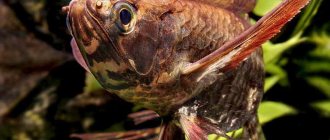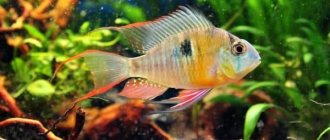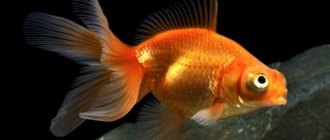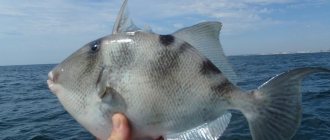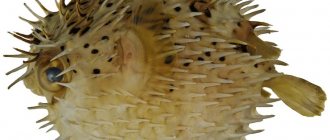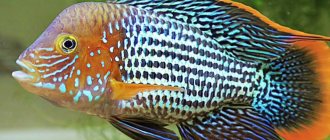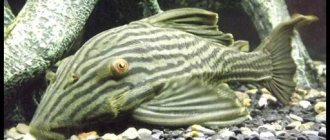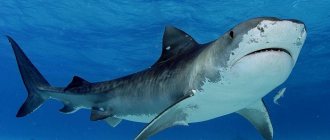LiveInternetLiveInternet
The tweezer butterfly naturally lives in the Indian Ocean, near the shores of the Great Barrier Reef in Australia, Singapore, Melanesia and Papua New Guinea. This fish has many names: butterfly fish, big-nosed helmon, copperband butterflyfish, copperband tweezers, etc. Usually the fish live in areas of coastal rocks and shallow lagoons, where the water is calm and warms up well. I would like to warn you right away that these fish are very difficult to keep in an aquarium and can only be recommended to trained amateur aquarists. This interesting and beautiful fish got its name due to its appearance, namely because of its particularly elongated and pointed snout, reminiscent of tweezers in shape.
The large black spot at the top of the dorsal fin is a false eye, designed to deceive predators, whom it misleads when attacking, as a result of which they attack not from the head, but from the tail, thereby giving the butterfly fish a chance to swim away.
These fish are very popular among marine aquarium enthusiasts, but butterfly fish are not only loved for their beautiful appearance, they are also considered the most effective fighters against aiptasia (glass roses), which are a big problem for many marine aquarium enthusiasts.
Helmonfish can be considered one of the most difficult marine aquarium fish to keep; they are very whimsical, difficult to adapt to new living conditions and have difficulty adapting to unusual food. The initial stage is especially difficult; during this period, the fish have difficulty feeding, are very shy and highly susceptible to stress.
One of the most important aspects of keeping helmons in an aquarium is feeding. Fish of this species can refuse food artificially introduced into the aquarium for two to three weeks and eat only what they find on the rocks. However, no matter what, you should continue to offer the fish food in the widest possible abundance so that it is always in their sight.
Chelmons do not immediately adapt to aquarium conditions and food, but over time they get used to eating the food offered. To maintain health, your fish's diet should be varied. They must be fed 2-3 times a day.
Having become accustomed to the aquarium, the helmons become almost tame and eagerly take food directly from the owner’s hands.
https://houseaqua.ru/987-chelmon-rostratus.html
Similar fish
Moorish idol (Zankl)
Externally, zankles and damselfish fish are similar to butterfly fish. The latter are inferior in color to butterflies.
Moorish idol (Zankl) M
9250 rub.
Add to cart
HIT
Monodactyl silver (Silver swallow) - sea S
959 rub.
Add to cart
Butterfly tweezer-helmon (Nosed helmon)
Belongs to the family Butterflyfish / Chaetodontidae
Chelmon rostratus Coperband butterfly
Family Butterflyfish (Chaetodontidae)
Dimensions: About 20 centimeters.
Description Tall-bodied butterfly with a long elongated snout. The main color tone is white with a silver or golden tint. The memorable striped pattern on the body consists of five wide golden-orange vertical stripes with dark edging. The first stripe passes through the eye, and the last along the posterior edge of the dorsal and anal fins through the base of the tail. In the upper part of the fifth stripe there is a large rounded black spot with a blue border. A thin orange stripe extends from the forehead to the tip of the nose, and the caudal peduncle is surrounded by a black ring. Juveniles are indistinguishable from adults in color. There is no sexual dimorphism.
Distribution Distributed in the Western Pacific from the Andaman Sea to the coast of Australia.
Biology Inhabits closed lagoons, estuaries, waters near coastal cliffs, silted reefs. Found at depths of up to 25 meters. This territorial species lives alone or in pairs. Tweezer butterflies professionally extract their food - various small invertebrates - from cavities on the reef or from the ground using their long tweezer snout.
Keeping in an aquarium A very interesting butterfly, popular among aquarists. The main problem during adaptation is food specialization: these butterflies are accustomed to extracting food from the substrate and they do not immediately learn to catch food in the water column. To keep one individual, an aquarium with a volume of at least 300 liters is required, preferably with a large number of live stones. Temperature 22 – 26 degrees, pH 8.1 – 8.4.
Food The diet of these butterflies consists of animal food. Live small bloodworms, tubifex, enchytraeus can be combined with finely chopped meat of shrimp, mussels, squid, and fish fillets. Pincer butterflies will happily eat small invertebrates from cavities in living rocks. When kept with other fish, you need to make sure that these butterflies have enough food. You should feed three times a day.
Compatibility Since pincer moths actively hunt invertebrates, in a reef aquarium they will cause significant harm to corals, sea anemones, mollusks, worms and small arthropods. They are very territorial and aggressive towards members of their own species. Only in an aquarium with a volume of more than 1000 liters can an established pair of these butterflies be housed, and even then conflicts can arise. Butterflies can drive smaller fish out of their territory, but they are able to withstand the onslaught of larger neighbors, such as angels and surgeons. They can pluck skin outgrowths and fins of sedentary fish, for example, hedgehog fish. This species is recommended for use in a reef aquarium to control glass anemones (Aiptasia sp.), however, this must be done carefully, since after the destruction of these coelenterates, the butterflies will switch to other invertebrates.
For reference: Butterflyfish family (Chaetodontidae)
One of the brightest and most beautiful families of marine fish, the hallmark of coral reefs, has 10 genera and up to 130 species. In classical works, butterfly fish are often combined with angel fish, which are not inferior to them in beauty and brightness of color, with which they have many common morphological features. Butterfly fish are distributed mainly in the Indian and Pacific oceans, but they are also found in the Atlantic, not only in tropical and subtropical waters, but also in temperate waters. All species live in the coastal zone, inhabiting mainly communities of coral reefs and rocky outcrops. They are very conservative, do not migrate and stick to the same area throughout their lives. They live alone, without forming flocks or aggregations. They lead a diurnal lifestyle. These fish feed on various invertebrates, which are usually taken from crevices and other shelters, collected from the surface of reefs, or eat parasites from the skin of large fish.
Small fish, from 7 to 30 centimeters, with a tall, very laterally compressed body. The rostral part of the head is elongated into a tube, at the end of which there is a small mouth. The dorsal fin is undivided, stretches along the entire body, sometimes has an enlarged front part, resembling a feather. The most typical combination of black and yellow colors for butterfly fish, there is also a combination of black and silver, and bright red, orange and blue spots on a yellow background. A characteristic feature of these fish is the complete absence of age dimorphism. The fry are colored exactly the same as the adults, unlike angelfish, whose fry have a completely special coloration.
Butterfly fish are one of the most popular saltwater aquarium fish. Almost no reef aquarium can do without them. Several species of butterfly fish get along well with other species of coral fish. However, to maintain multi-species groups, a very spacious aquarium is required, since in small volumes they begin to conflict with each other. Since these fish are quite conservative and territorial, when populating an aquarium, all its inhabitants should be planted at the same time. As soon as the fish settle in and occupy suitable areas, any newcomers become unwelcome guests and are carefully driven out.
These fish require a spacious aquarium, preferably at least 300 liters. They feel best in reef aquariums, with a lot of rocks, crevices, and shelters. They get along only with large invertebrates, while small ones are perceived by them exclusively as food. Water quality is the most important indicator when keeping these and many other coral fish. In captivity they feed on shrimp, brine shrimp and chopped shellfish meat.
Conditions of detention
Butterfly fish need spacious aquariums of 300-400 liters. They are usually kept alone, with the exception of several species of butterflies that can be kept in a flock in an aquarium (for example, the white-tipped pennant butterfly). When keeping different types of butterflies in one aquarium, its volume should be much larger in order to avoid skirmishes and fights (from 500-700 liters).
Suitable water parameters for butterflies: temperature +24…+26 degrees, acidity pH 8.1-8.4, salinity 1.020-1.025. An aquarium with butterfly fish should have a sufficient amount of live rocks: the fish use them as shelter and as an additional source of food, collecting invertebrates in their crevices.
Butterflies are not easy to keep. They can be recommended to professional aquarists in a well-established aquarium.
Milk butterfly (linear)
Feeding
Butterfly fish are picky eaters. In captivity, it is sometimes difficult to switch to frozen and artificial food. They prefer live tubifex, bloodworms, frozen brine shrimp, seafood, and fish meat. It is difficult to get used to dry food.
An additional source of food for butterflies can be various inhabitants of living stones and glass anemones.
Raccoon butterfly (lunula)
Reviews of butterfly fish
Dmitry, review of the cuneiform butterflyfish
A very interesting, beautiful and lively fish. Adapts well to a new place. As long as it doesn't touch the corals. A peaceful fish, it doesn’t chase anyone, sometimes it gets into trouble with the dascil. She gets fat very easily, eats any frozen food, as well as raw shrimp. It’s a pity that he’s not looking at the pieces of glass yet, he wanted to destroy them.
Artyom, review of the pennant whitefin butterfly
A beautiful, unpretentious fish (named Fedor). Pretty boring behavior. You also need to take into account that they can bite the fins of other fish. If the aquarium is less than 500 liters, it may not take root. Perfect for a fish jar with active fish. (Arotrons, surgeons, zebrasomes) True, some comrades may bite their pennant.
Oleg, review of the tweezer-helmon butterfly
Butterfly tweezer-helmon (Nosed helmon)
A beautiful, unpretentious fish (named Fedor). Pretty boring behavior. You also need to take into account that they can bite the fins of other fish. If the aquarium is less than 500 liters, it may not take root. Perfect for a fish jar with active fish. (Arotrons, surgeons, zebrasomes) True, some comrades may bite their pennant.
Dmitry, review of the yellow tweezer butterfly
A very interesting fish in behavior, active, beautiful, bright. Does not show aggression towards other fish. Loves a varied diet: brine shrimp, tubifex, shrimp. So far there is zero attention to corals - they don’t touch them at all.
Disadvantages: Only those specimens that are well fed survive. You can't scare. Requires a long time to adapt.
Ephippium butterfly (black-backed)
